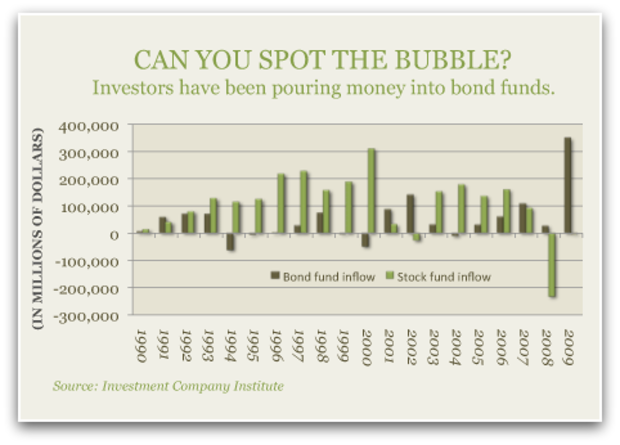Bond Funds: Bubble Ahead
Mutual fund investors piled into bond funds last year like circus
clowns in a VW Beetle. New
href="http://www.ici.org/research/stats/trends/trends_12_09">cash flow into
bond funds totaled $375 billion last year, according to the Investment
Company Institute, and more than two-thirds of that money came from individual
investors. To put that figure in perspective, the total new bond-fund cash flow
for the previous 10 years combined was $423 billion. As you can see in
the chart below, more money flowed into bond funds last year than flowed into
stocks right before the tech bubble burst. Yet bonds look less attractive now
than at any point in recent memory. So you should probably be a little worried
about the near-term outlook for your bond fund holdings.
The Bond Fund Bubble
Lately, the phrase “
href="http://www.smartmoney.com/investing/bonds/the-new-bond-bubble/">bond bubble”
is increasingly being bandied about. Nearly a year ago,
href="http://uk.reuters.com/article/idUKTRE51R1Q720090228">Warren Buffett compared
the Treasury market to the earlier housing and internet stock bubbles. In
December, Citigroup chief equity strategist Tobias Levkovich called investors’
stampede into fixed income “
href="https://www.citigroupgeo.com/pdf/SNA45445.pdf">quite
worrisome,” with bond fund cash flow nearing “three
standard deviations above average” (a level of risk so far from normal
that you might expect to see it just one percent of the time).
So, bond fund investor: What should you do now?
Reason for Concern
A good first step would be to gain an understanding of why
so many strategists are concerned. It starts with the textbook relationship
between bond yields and bond prices.
During the credit crisis, Treasury bond yields fell to a
multi-decade low. As yields dropped, of course, bond prices rose — to
what many analysts felt are now unsustainable levels. When yields reverse
course and begin to rise, as many economists expect to happen in 2010, bond
prices will head south.
The turn has already begun for long-term bonds, providing a
preview of what the future might hold for investors in short- and
intermediate-term bond funds. The yield on 20-year Treasury bonds, for
instance, has risen about 1.5 percentage points in just over a year, causing
the Barclay’s Long-Term Treasury Bond index to fall by 13 percent.
As MoneyWatch blogger
href="http://moneywatch.bnet.com/economic-news/blog/macro-view/the-year-in-pictures-interest-rates-and-a-bond-tutorial/1458/">John
Keefe notes, added danger comes from the bond market’s current
steep yield curve. Long-term rates are high relative to short-term rates. That
generally means rates will head up, as they do historically after times like
this.
5 Rules for Bond Fund Investors Now
Regardless of how much rates rise and when, you’ll
still want to own one or more bond funds for diversification. Follow these five
rules to navigate what could be a rough time ahead.
1. Embrace reality
The bull market in bonds is a thing of the past. For 27
years, falling yields boosted returns to levels rivaling stock returns. That
was then. So if the
href="http://moneywatch.bnet.com/economic-news/article/why-it-wasnt-a-lost-decade-for-investors/375568/">equity
market’s “lost decade” prompted you to look
for growth through fixed-income funds, you’re likely to be
disappointed. Given current yields, annual returns on intermediate-term Treasury
bonds over the coming decade will likely be about half the 8.4 percent they
provided from 1982 through 2008.
2. Be careful what you wish for
If interest rates don’t shoot up, but remain
flat, bond prices won’t move. That’s fine from a stability
standpoint. But this scenario implies that the Fed must keep rates at their
current low levels to stimulate a faltering economy, which is nothing to cheer
about. What’s more, it wouldn’t take much of a
href="http://moneywatch.bnet.com/investing/blog/against-grain/treasury-bonds-the-risksin-avoiding-risk/122?">rise
in inflation before those yields turned negative in real terms.
3. Focus on the long term
As I’ve written on MoneyWatch, following the
market’s winds into and out of one asset class after another is a
href="http://moneywatch.bnet.com/investing/blog/fund-watch/how-not-to-invest-in-mutual-funds/350/">recipe
for failure. Instead of devising your asset allocation in response to a
market’s short-term moves, create a portfolio for the long term. Stocks
will provide the growth you’ll need to reach your financial goals;
bonds will give you peace of mind when stocks take a tumble. Once you’ve
chosen a mix balancing your need for growth with your desire for protection, resolve
to stick with it. Yes, owning a bond fund will mean taking a bit of a haircut
on the bonds in the fund when rates rise. But the fund will also invest in new,
higher-yielding bonds, which will soften the blow.
4. Stay short with your bond funds, for now
The longer a bond fund’s
href="http://en.wikipedia.org/wiki/Bond_duration">duration, the further it
will decline in price if interest rates rise. And with rates more likely to
rise than to fall in the next few years, you might consider trading a bit of
current income for protection from rising rates by favoring short-term bond
funds. Then, plan to shift a proportion of your short-term bond fund holdings
into longer-term bond funds at fixed intervals over time.
5. Be careful reaching for yield
With rates so low, it can be tempting to try to goose your
yield, particularly when junk bond funds are sporting seven to nine percent
yields. But remember: Markets aren’t dumb. Higher-yielding
investments are accompanied by
href="http://moneywatch.bnet.com/investing/blog/irrational-investor/the-limited-role-of-high-yield-bonds/832/">more
risk. High-yield bonds are called “junk” because of
their high default risk. If their issuers go under, the bonds may become
worthless. As investment advisor Bill Bernstein has noted, more money
has been lost in reaching for yield than has been lost in the stock market.
More on MoneyWatch:
-
href="http://moneywatch.bnet.com/investing/article/investing-in-2010-stocks-bonds-and-commodities/374058/">Investing
in 2010: Stocks, Bonds and Commodities -
href="http://moneywatch.bnet.com/investing/blog/irrational-investor/the-limited-role-of-high-yield-bonds/832/">The
Limited Role of High-Yield Bonds -
href="http://moneywatch.bnet.com/investing/blog/against-grain/treasury-bonds-the-risks-in-avoiding-risk/122/">Treasury
Bonds: The Risk in Avoiding Risk -
href="http://moneywatch.bnet.com/investing/blog/fund-watch/how-not-to-invest-in-mutual-funds/350/">How
Not to Invest in Mutual Funds -
href="http://moneywatch.bnet.com/investing/article/the-biggest-mistake-investors-make/355397/">Biggest
Mistake Investors Make -
href="http://moneywatch.bnet.com/investing/blog/wise-investing/does-diversification-still-work/1191/">Does
Diversification Still Work?
